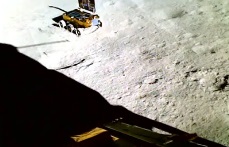For many kids in India, the moon is usually referred to Chandamama as their mothers show it to them while feeding them.
The Indian Space Research Organisation (ISRO) recently rotated the moon rover for a safe navigation route. The movement was captured by a camera on the moon lander and was transmitted to the ISRO.
Uploading the video on the social media platform X, the ISRO said: “It feels as though a child is playfully frolicking in the yards of Chandamama, while the mother watches affectionately. Isn’t it?”
However, looks may be deceptive, as the 26kg rover is actually into serious business.
According to the ISRO, one more instrument on the rover confirmed the presence of sulphur (S) in the region through another technique.
The Alpha Particle X-ray Spectroscope (APXS) has detected S, as well as other minor elements.
“This finding by Chandrayaan-3 compels scientists to develop fresh explanations for the source of Sulphur (S) in the area: intrinsic?, volcanic?, meteoritic?,……?” the ISRO said.
Recently, ISRO said the rover has found the presence of oxygen, aluminium, sulphur and other materials near the lunar south pole, while investigation regarding the presence of hydrogen is underway, the Indian space agency added.
According to the ISRO, the Laser-Induced Breakdown Spectroscopy (LIBS) instrument onboard Chandrayaan-3 rover has made the first-ever in-situ measurements on the elemental composition of the lunar surface near the south pole.
These in-situ measurements confirm the presence of sulphur in the region unambiguously, something that was not feasible by the instruments onboard the orbiters. LIBS is a scientific technique that analyses the composition of materials by exposing them to intense laser pulses. A high-energy laser pulse is focused onto the surface of a material, such as a rock or soil.
The laser pulse generates an extremely hot and localised plasma, ISRO said. The collected plasma light is spectrally resolved and detected by detectors such as Charge Coupled Devices. Since each element emits a characteristic set of wavelengths of light when it’s in a plasma state, the elemental composition of the material is determined.
According to ISRO, preliminary analysis, have unveiled the presence of aluminum (Al), sulphur (S), calcium (Ca), iron (Fe), chromium (Cr), and titanium (Ti) on the lunar surface.
Further measurements have also revealed the presence of manganese (Mn), silicon (Si), and oxygen (O).
LIBS payload is developed at the Laboratory for Electro-Optics Systems (LEOS)/ISRO, Bengaluru.
India on August 23 reached the Moon with its lander safely landing on the lunar soil in a text book style. Later the rover rolled down and started doing experiments.
–IANS
vj/vd





























